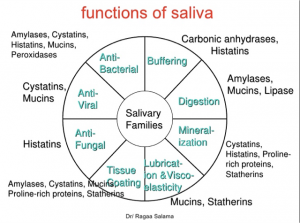The Important Role of Saliva in Oral Health
- 8 May 2017
- 0
- Tooth Damage and All About Enamel
The mouth is vulnerable to the outside world. It is believed to be the most challenging part of our body to protect against bacteria. Fortunately, it has amazing defense mechanisms to protect us. If fact, one of these mechanisms is crucial to preserving our oral health. Saliva, which is also known as spit, plays many roles in our body and provides the following:
- Antibacterial protection.
- Antiviral protection.
- Antifungal protection.
- Cleaning, lubrication, and coating for the surfaces of tissues to allow for smooth speech.
- Assisting the body in the digestion of foods.
- Buffering and mineralization capacity to neutralize acids and protects enamel and dentinal structures of teeth.
How Saliva Works
The oral environment is at neutral status when it has a pH level of 6.3, which is very close to pH 7. Furthermore, the environment is challenged by acids all the time and is constantly undergoing changes. While this occurs, saliva provides buffering capacity in this acidic challenge.
Remember, acidity increases when bacterial biofilm grows on our teeth, or we are eating any type of food in general. Some foods and drinks are very acidic. It’s a subject talked about in a previous post before.
The salivary flow rate is the non-stimulated production of spit in the mouth. Normal flow is considered between 0.3 – 0.5 ml/min. When the flow rates are lower than that (or less than 0.1 ml), the condition is called hyposalivation. The condition where one does not have enough spit is called xerostomia.
In the end, saliva baths teeth and keeps them clean and in balance to protect them from daily exposure. In many cultures, traditions believed that saliva had natural healing properties. If a small injury occurred, they would place a bit of saliva on the wound to naturally disinfect the site, neutralized acids and promote healing.
Join us next week, when we discuss how saliva protects the enamel.
